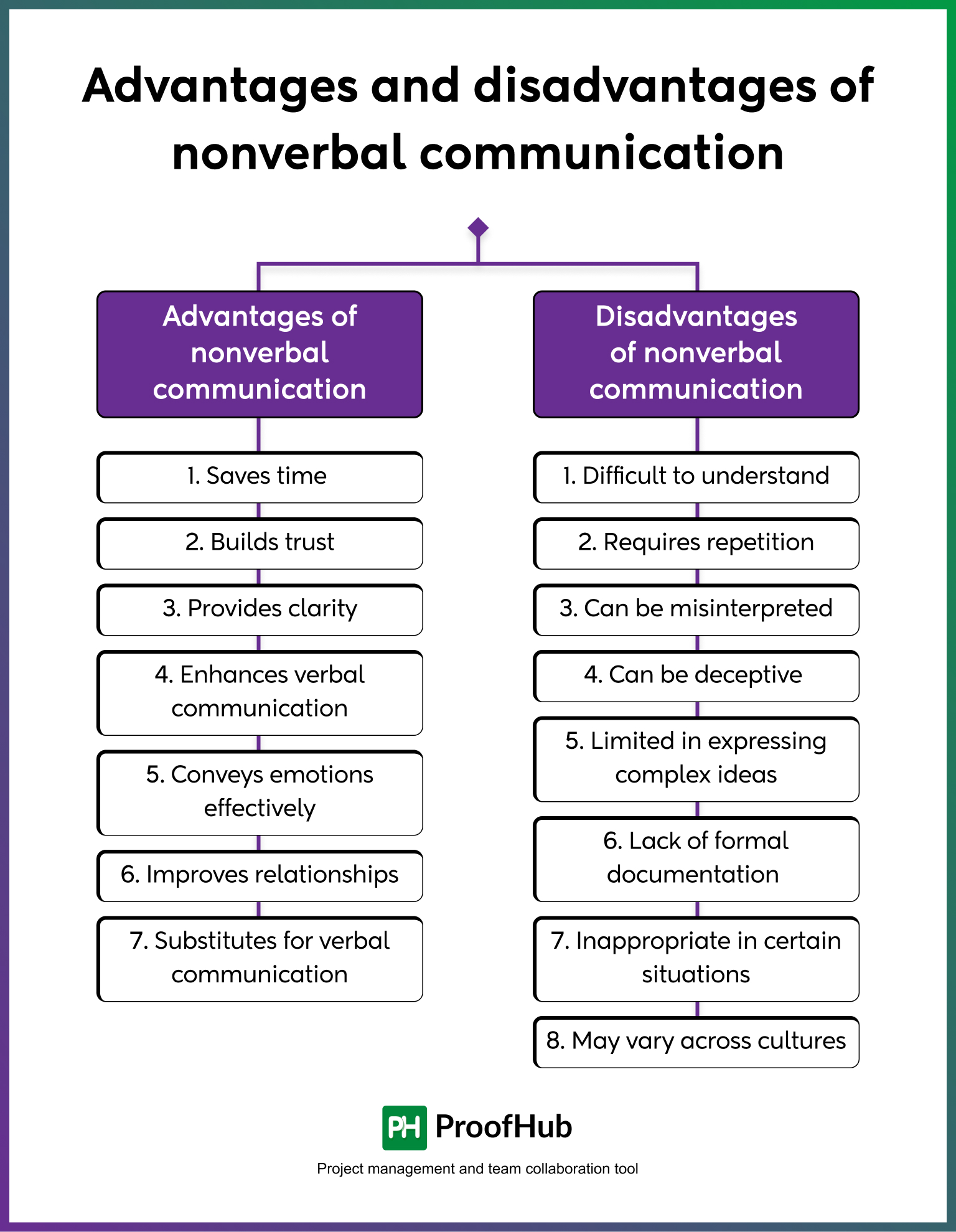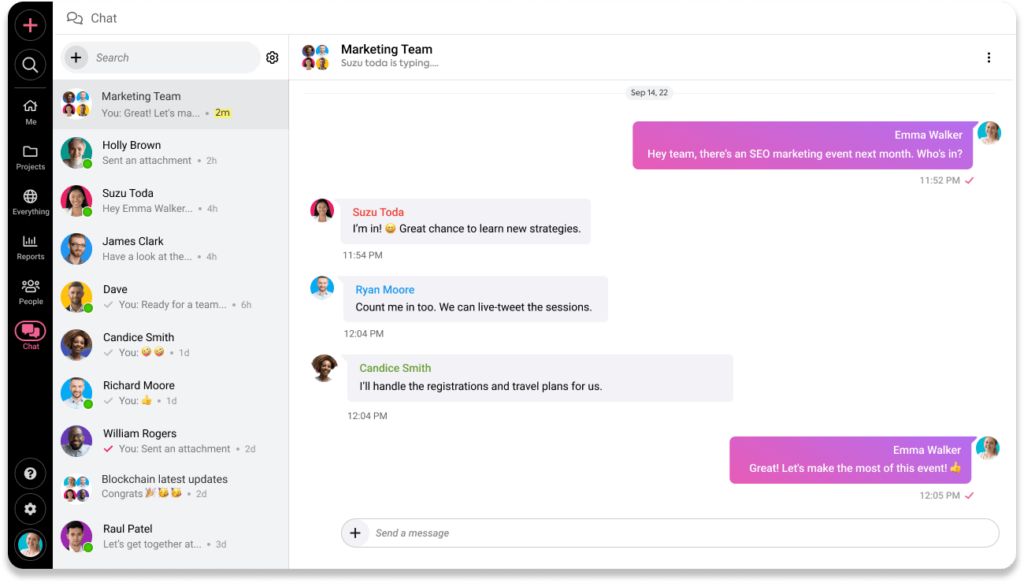Introduction
Let’s explore the advantages and disadvantages of nonverbal communication in our day-to-day activities.
Nonverbal communication is an integral part of our communication realm.
A simple wave of your hand, a thumbs up, eye contact, voice tone, physical touch, and space are all frequently used in nonverbal communication. These subtle cues help you understand and influence people in your surroundings.
As much as nonverbal cues provide you with ease of communication and increased advantage for seamless communication, there is another realm as well. There are chances for misinterpretation and confusion when using nonverbal cues in the workplace.
You need to understand both sides of the coin for a seamless practical application and to eliminate misinterpretation and misunderstandings. This is what you will learn in the below sections.

Advantages of nonverbal communication
As an individual, nonverbal communication helps you to converse confidently and understand the people around you. When you have a strong command over your nonverbal communication skills, you can enjoy numerous advantages in your everyday life.
Be it in a professional environment or your personal life, nonverbal communication will help you portray your ideas effectively, and understand your peers with ease.
Few of the top advantages of nonverbal communication are listed below.
1. Saves time
Effective communication in the workplace is necessary to convey messages and information with clarity. Non-verbal communication helps you convey messages and information clearly and quickly with minute gestures and movements. You can convey information without the need for speech or other mediums.
When you adopt nonverbal communication, you can save time in writing or texting messages and emails. Consider the time and effort it will take for you to say – “I accept” or “I agree” to your peer standing a block away. You can just show a thumbs up for the same.
However, this does not hold true when employees are working remotely. You need to rely on verbal communication. But, modern-day collaboration tools provide a comprehensive set of emojis to imitate non-verbal communication gestures. My favorite in ProofHub chat is ‘👍’ for agreements. These emojis make chat interactive, save time in the workplace, and help you show emotions. 😃
Try ProofHub chat for free!

2. Builds trust
Nonverbal communication helps you connect efficiently with the person you are conversing with.
By observing nonverbal cues, you can understand the interest and concentration of the person you are conversing with. This will help you engage positively and convey information with intent.
With effective nonverbal communication, you can build a comfortable environment. This is a two-way channel that helps you share ideas and information with ease among your peers.
3. Improves relationships
Nonverbal cues help you build healthy bonds with the people you are conversing with.
For instance, when you understand the comfort level of the other person you can look forward to an elongated handshake. You can display openness, encouraging your team members to come up with innovative ideas.
In your personal life, understanding nonverbal cues will help you relate closely with your loved ones. This will help you build a strong, healthy, and happy bond.
4. Enhances verbal communication
Verbal communication comprises just 7% of the communication process, according to research by the University of Texas.
When you use nonverbal cues, you complement your verbal speech. This helps you transmit information and messages effectively.
When delivering a presentation you will have to vary the pitch of your tone to convey emotions of achievement or failure. When you deliver in a monotonous tone, the audience will not understand the impact of the presentation.
Nonverbal cues add essence to your verbal speech and help you convey information with ease.
Simplify communication among your team with these best team communication tools for businesses.
5. Conveys emotions effectively
Visual cues help you subtly convey emotions. Small signals like the blink of an eye or unusual jaw movement are sufficient to understand the mindset of the listener.
Further, you can portray openness when you keep your arms open. This sends out a message that you are receptive and open to criticism.
You can also create and hold eye contact to connect effectively with your audience. By observing the eyes of the listener you can perceive the emotions of the listener.
6. Provides clarity
Nonverbal and visual cues enhance the clarity of your conversations. When you understand the visual cues of the person you are talking with, you can connect deeply.
For instance, you can vary the pitch of your voice to indicate authority and confidence. Similarly, the physical distance between you and the person you are conversing with indicates your comfort level. This helps eliminate misunderstandings, lowers the communication gap, and helps convey information with clarity.
Especially in the workplace, nonverbal cues along with documented and streamlined interactions on project management software like ProofHub help ensure effective internal communication within teams. This clarity helps in project management and builds a seamless channel for communication to convey information effectively to team members.
7. Substitutes for verbal communication
Just like we saw in the first point, you can use simple hand gestures to communicate. This saves time and comes in as a substitute for verbal communication.
In places with extreme noise levels like stadiums or factory work floors, you could use gestures or hand movements to communicate. In places like libraries and hospitals, you can communicate with eye contact or subtle cues.
At the workplace, you can use nonverbal cues to understand the comfort level of your colleagues. While addressing your peers, you can look for cues that determine their level of interest and engagement in the conversation. This will help you strengthen internal communication and build efficient team bonding.
Disadvantages of nonverbal communication
Although nonverbal communication provides numerous advantages in the workplace, there are certain disadvantages as well.
While engaging in nonverbal communication with your peers, you need to ensure that you are aware of the surrounding complexities. The complexities in understanding and showcasing an image can lead to misunderstandings.
The following are the most commonly faced disadvantages of nonverbal communication.
1. Difficult to understand
While using nonverbal communication, you cannot expect everyone to understand your visual cues. This is because the visual cues differ based on cultural and regional factors. Further, you will not be able to converse nonverbally with ignorant people.
For instance, a tight grip while shaking hands will indicate confidence, while some may interpret it as aggressive behavior.
2. Requires repetition
Nonverbal cues are quick and may get lost in transit. In such cases, you must either repeat your cue or elongate it longer. This lowers the enthusiasm in the conversation.
For instance, when doing an eye flash to portray surprise or excitement, it so happens in some cases that the receiver does not see the same and you will have to repeat your cue.
3. Can be misinterpreted
Misinterpreting visual cues is one of the most prominent disadvantages of nonverbal communication. This causes misunderstanding and even major conflicts in some cases.
Misinterpreting is most common in haptic communication. Touch can be perceived in multiple ways. While it may be completely normal to share an embrace to express joy or grief, certain cultural and religious groups have a large physical and social space. In such cases, it causes disrespect.
Eliminate misinterpretations and enhance workplace communication with these best employee communication software.
4. Can be deceptive
Nonverbal cues breed uncertainty. Since most of the cues are localized, there are chances that the person you are communicating with does not understand your context.
For instance, candidates try to mask their real behavior during interviews. They tend to display confidence and honesty. It becomes difficult in such situations to identify the real behavior and characteristics of the candidate.
Similarly in the workplace, you should build effective communication strategies for connecting with your peers and team members. Deceptions and masked communication will build imbalance in the workplace.
5. Limited in expressing complex ideas
Nonverbal cues are limited and do not support when it comes to sharing large and complex ideas. Environmental factors like distance, ambiance, and noise levels also affect nonverbal cues.
Team communication is essential to ensure timely completion of tasks and projects. With limited communication channels, expressing complex ideas is hindered.
For instance, in a remote work environment, you will have limited access to a shared workplace. This physical distance makes it difficult to share information nonverbally.
Unlock the potential of your remote workforce with these cutting-edge remote work tools, facilitating effortless communication of complex ideas.
6. Lack of formal documentation
Nonverbal communication are cues that cannot be documented. Also, similar cues have different meanings in different places and religions.
For instance, your boss shows you a ‘thumbs up’ for approval but later steps back on his words. This happens because you do not have documentary proof of approval.
7. Inappropriate in certain situations
Nonverbal communication is specific to certain situations. In the workplace, the advisable eye contact is between 4-5 seconds. If you cross that limit, it is considered to be staring, depicting authority, or disrespectful.
Further, certain visual cues like body language and posture can be identified differently across different cultures and traditions. Overlapped legs portray status and command in certain regions, while the same is interpreted as insult and rude behavior in other regions.
8. May vary across cultures
The differences in nonverbal communication are highlighted vividly across cultures as well. In certain cultures, people cover their faces with a veil. This makes it difficult for lip reading, eye contact, and understanding the voice tone.
Further, Mediterranean and Arabian men tend to exaggerate grief and sorrow whereas in American culture men hide their grief and sorrow. In such cases, it becomes difficult to understand the cues and emotions people tend to portray.
Bottom line
It is safe to say that nonverbal communication has both advantages and disadvantages. The advantages come in the form of quick relay of information – saving time, building trust, and many others. However, misinterpretation of nonverbal cues is a concern.
Ignorant behavior is one of the primary reasons for the numerous disadvantages that I listed above. There are instances when people tend to focus only on verbal communication and ignore the nonverbal part.
Continuous training with increased awareness about the advantages of nonverbal communication will help in progressive growth in your career.
You will have an enhanced understanding of your surroundings and simplify the communication process.
Related articles:
- How to improve your non-verbal communication skills?
- 11 Tips to improve your nonverbal communication skills
- Your guide to nonverbal communication in project management
FAQs
What are the advantages of gestures in nonverbal communication?
Gestures help in conveying subtle cues and information that help in enhancing your communication. You will be able to share your ideas and information with ease. Further, gestures will help you understand your peers and develop an effective bond.
How does nonverbal communication enhance relationships?
Nonverbal communication enhances relationships by conveying emotions, fostering empathy, and building trust. This helps in developing effective understanding between people with stronger bonds with mutual understanding and respect.
Can nonverbal communication improve workplace dynamics?
Nonverbal communication can improve workplace dynamics by developing trust, understanding, and collaboration. Visual cues like eye contact, body language, and facial expressions can convey empathy, build rapport, and improve teamwork.
What are the benefits of silence in communication?
Silence helps in active listening, allowing individuals to absorb information fully. This encourages reflection, leading to thoughtful responses and a deeper understanding of the incoming information. In other instances, silence also plays a key role in diffusing tension, helping in introspection, and portraying empathy.
What challenges may arise from misinterpreting nonverbal cues?
Misinterpreting nonverbal cues will lead to conflicts and misunderstandings. In the workplace, misinterpreting nonverbal cues will hamper collaboration, decision-making, and leadership. In other cases, misinterpreted nonverbal cues create an imbalance in the workplace due to a lack of trust and respect.

